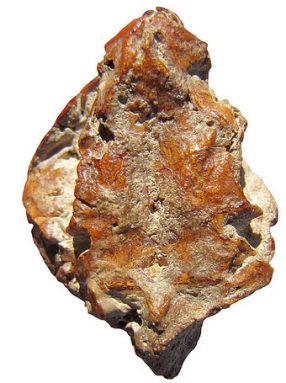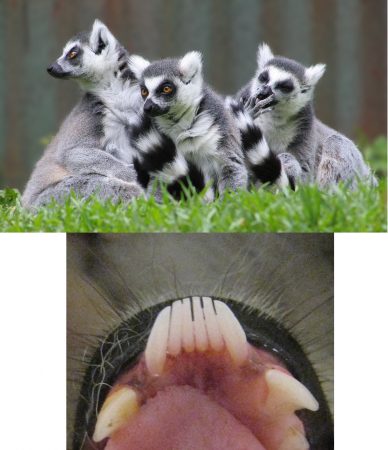A fishy mammal ID
For more than a century, the fossilized skull of an ancient fish was misidentified as a primate
Share this:
- Share via email (Opens in new window) Email
- Click to share on Facebook (Opens in new window) Facebook
- Click to share on X (Opens in new window) X
- Click to share on Pinterest (Opens in new window) Pinterest
- Click to share on Reddit (Opens in new window) Reddit
- Share to Google Classroom (Opens in new window) Google Classroom
- Click to print (Opens in new window) Print
By Sid Perkins

Ever make a big error on your homework? A really embarrassing one? Don’t worry. Even well-trained scientists can make a whopper of a mistake now and again.
In the 1890s, paleontologist Florentino Ameghino began studying a small fossil skull that had been given to him by a local collector, in Argentina. At first glance, the broad, chisel-like teeth at the front of the skull — the only part of the fossil not covered with rock — looked like those belonging to lemurs. A distant relative of apes and monkeys, lemurs are a type of mammal that now lives only on the island of Madagascar, off the southeastern coast of Africa.
But after Ameghino removed more rock from the fossil, he realized the skull was unlike any other lemur. The reason: It had no snout. When Ameghino described the fossil in a research paper, he named the new species Arrhinolemur scalabrinii. This very descriptive name, in Greek, means “Scalabrini’s lemur without a nose.” (The name given to a species often honors the person who discovered one of the first fossils of the organism, and is typically either Greek or Latin.)
Many years later, other scientists removed even more rock from the fossil, exposing the entire skull. When the famous paleontologist George Gaylord Simpson looked at the skull in the 1940s, he realized that — surprise! — it didn’t belong to an ancient lemur. He thought that maybe it hadn’t even been a mammal. It seemed to resemble a fish. But Simpson never completed a detailed analysis, and neither did another paleontologist who studied the fossil four decades later.
Now, 114 years after the fossil was first described by Ameghino, South American paleontologists have teamed up with fish experts from the United States to thoroughly study the unusual skull. “This is the first detailed examination of this fossil,” says Brian Sidlauskas of Oregon State University in Corvallis. Scientists like Sidlauskas who specialize in fish are also known as ichthyologists (ICK thee OL oh jizts).
The team’s new analysis suggests that Ameghino started out on the right track, but he didn’t go far enough. For instance, the teeth seen at the front of the creature’s mouth — the only bones exposed when Ameghino first described the fossil in the 1890s — “certainly look mammalian,” says Sidlauskas.
“Looking at just the teeth, it’s easy to get the idea you’re looking at a mammal,” says John Lundberg. He’s an ichthyologist at the Academy of Natural Sciences in Philadelphia who wasn’t involved in the study.
The rest of the creature’s skull, however, definitely appears fishy — literally. “Just at a glance, you could tell it wasn’t a mammal,” Lundberg observes.

Sidlauskas specializes in the study of fish that belong to a genus, or group of species, called Leporinus. That’s why the South American paleontologists recruited him for their team. They believed the skull actually came from an extinct and previously unknown species of Leporinus, and they wanted this expert’s opinion.
Sidlauskas concurs that the skull and teeth are uniquely shaped. So, the ancient fish indeed belongs to a new species, one the scientists have just renamed Leporinus scalabrinii.
Sidlauskas and his coworkers “have done a very professional analysis,” says Lundberg. Their results emphasize that being familiar with the skeletons of modern creatures really helps paleontologists accurately classify fossils of ancient animals, he explains.
The mistake that Florentino Ameghino made 114 years ago makes it clear that it’s very important to remove as much rock from a fossil as possible before describing it. Concludes Lundberg: “It’s easy to be led astray if you look at just a few aspects of a fossil.”
Power Words
fossil Any preserved remains or traces of ancient life. There are many different types of fossils: The bones of dinosaurs are fossils, as are their footprints. Even specimens of dinosaur poop — also known as coprolites, which in Greek means “dung stones” — are fossils. Coprolites are very important because they provide direct evidence of what ancient creatures ate.
genus A group of closely related species. For example, the genus Canis — which is Latin for “dog” — includes all domestic breeds of dog and their closest wild relatives, including wolves, coyotes, jackals and dingoes.
ichthyologist A biologist who specializes in studying fish.
paleontologist A scientist who specializes in studying fossils, the remains of ancient organisms.
primate The order of mammals that includes humans, apes, monkeys and related animals (such as tarsiers, the Daubentonia and other lemurs).







